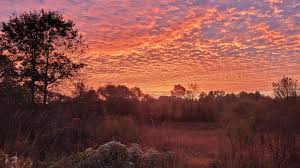Spine-Tingling Noises in Virginia’s Wildlife Refuge Identified – Coyotes are Behind the Eerie Howls!
In Northern Virginia, strange and spine-chilling sounds at night have left many people wondering: what’s making that noise? The eerie howls echoing through the darkness in the Occoquan Bay National Wildlife Refuge have now been linked to a surprising culprit – coyotes.
In a recent post on Facebook, the U.S. Fish and Wildlife Service shared a trail camera video that captured the source of these unsettling noises. It turns out that the howling chorus was from a group of coyotes boldly standing right in the middle of the road. The video, recorded at 2:23 a.m. on a cold January night, shows three coyotes making a loud and high-pitched noise.
The U.S. Fish and Wildlife Service describes the sounds as “absolutely letting it rip,” emphasizing the social nature of coyotes. Coyotes, which are known for their complex communication, use a mixture of yips, howls, and barks to talk to one another. These sounds are not random; they have specific purposes. They help coyotes locate each other, warn of potential threats, defend their territory, and sometimes even express emotion. As the service humorously notes, sometimes “you just need to scream into the void.”
These sounds, which are being heard more frequently in the area, have startled many people who live nearby. However, the howls aren’t just random noises. According to the U.S. Fish and Wildlife Service, the coyotes are reacting to various external stimuli – including the sound of police and fire sirens that sometimes echo through the refuge. Coyotes, being highly sensitive to sound, are quick to respond to these noises with their own vocalizations.
Coyotes’ Growing Presence in Virginia
The appearance of coyotes in Virginia is not entirely new, but their growing presence in areas like the Occoquan Bay National Wildlife Refuge is a relatively recent development. Historically, coyotes were primarily found in the prairies and desert regions of Mexico and Central North America. However, over the years, their range has expanded significantly, and they can now be found in many parts of North America, including urban and suburban areas.
Coyotes are highly adaptable creatures, which is one of the reasons they’ve been able to thrive in new environments. They are proficient hunters, capable of catching prey both in open spaces and dense forests. Coyotes are known for their remarkable speed, reaching up to 64 kilometers per hour (about 40 miles per hour). Their agility and sharp senses of sight, smell, and hearing make them excellent hunters, capable of detecting prey even in the thickest of vegetation.
In addition to their hunting abilities, coyotes have also become more comfortable living in close proximity to human populations. This adaptability has allowed them to expand into new territories, including Virginia’s wildlife refuges. As a result, these creatures are increasingly being spotted in more urban areas, where they continue to make their distinctive howls at night.
The Occoquan Bay National Wildlife Refuge
Located about 25 miles southwest of Washington D.C., the Occoquan Bay National Wildlife Refuge is a beautiful and diverse area that spans 642 acres. The refuge features a variety of upland and wetland habitats, providing a haven for many species of wildlife, including birds, amphibians, and mammals. As the coyotes continue to expand their range, they have made the refuge one of their homes, using the area’s dense forests and open spaces to hunt and live.
The recent increase in coyote activity in the refuge has sparked curiosity among locals, wildlife enthusiasts, and experts alike. The U.S. Fish and Wildlife Service encourages people to respect these animals’ space and to understand that their presence is part of the natural evolution of the area’s wildlife ecosystem. While coyotes may be new to the refuge, their return to the region signals a healthy environment where predators and prey can thrive.
The Mystery of the Howls Explained
So, what causes these haunting, high-decibel howls? Coyotes communicate through their vocalizations, and these sounds can serve various purposes. For one, howling is a way for coyotes to find each other when they are separated. It’s also a warning system to alert other members of the pack to potential dangers or threats. Furthermore, coyotes may howl to defend their territory, signaling to other animals that this area is already claimed.
Interestingly, coyotes don’t just howl at each other. As the U.S. Fish and Wildlife Service notes, the coyotes are also known to howl in response to human-made noises. The sound of sirens from nearby police and fire trucks is often enough to trigger a response from these animals, who seem to enjoy joining the noise with their own vocalizations.
The timing of these howls is also noteworthy. The video captured by the trail camera was recorded in the middle of January, when temperatures were a chilly 15 degrees Fahrenheit. Despite the cold, the coyotes’ vocalizations could be heard clearly, a testament to their resilience in tough conditions.
Why Coyotes Are Expanding Their Territory
Coyotes’ range expansion is not just a result of their adaptability but also due to changes in the environment. Urban sprawl, deforestation, and changes in wildlife populations have all contributed to the shifting habitats of coyotes. These creatures are resourceful and have found ways to live alongside human populations without much conflict. Their ability to survive in both rural and urban settings has made them one of the most successful predators in North America.
As coyotes continue to spread across new regions, wildlife experts will keep a close watch on their behavior and impact on local ecosystems. While these creatures may seem intimidating, they play a vital role in maintaining the balance of nature by controlling populations of smaller animals.
Conclusion
The eerie howls heard in the Occoquan Bay National Wildlife Refuge are not just a mysterious sound—they are a sign of the growing presence of coyotes in Virginia. These highly social creatures use their vocalizations to communicate with each other, defend their territory, and even react to human-made noises. As coyotes continue to expand their range across North America, their presence in urban and suburban areas will likely become more common. Understanding their behavior and respecting their space is crucial for coexisting with these fascinating creatures in the wild.
Disclaimer – Our team has carefully fact-checked this article to make sure it’s accurate and free from any misinformation. We’re dedicated to keeping our content honest and reliable for our readers.

